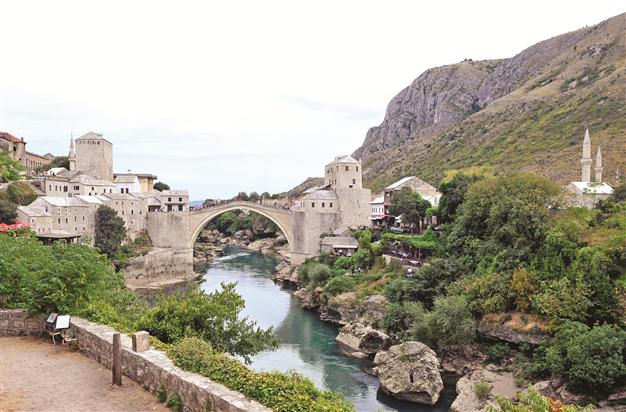Turkish projects seek to revitalize Ottoman architecture in Balkans
BURSA - Anatolia News Agency

Macedonian parliamentarian Behuciddin Şahabi says there are very few examples of Ottoman architecture remaining today in Macedonia. But when compared to other places in the Balkans, their number in Skopje is large. ‘After Turkey began to help sister societies in 2000, we achieved very good things,’ he says. Photo by Zekeriya Albayrak
A number of Turkish foundations are attempting to restore Ottoman structures left behind in the Balkans and the Middle East in an effort to prevent the disappearance of the empire’s legacy.
The Ottomans built many structures before leaving the Balkans, but there are very few examples that remain standing today, Behuciddin Şahabi, a Macedonian parliamentarian and former director of the Historic Artworks Museum, said during a recent visit to Istanbul.
Some of the structures were ruined by natural disasters, wars and immigration, while others were severely damaged, Şahabi said. “For example, there were more than 40 large mosques and 120 small mosques at the time of the Ottomans in Skopje, one of the most important centers in the Balkans. But there are only 24 structures today.”
When compared to other places in the Balkans, though, the number of Ottoman works in Skopje is large, Şahabi said.
“We have been restoring these structures thanks to donations that we have received, especially since 1990 with democratic movements,” Şahabi said. “After Turkey began to help sister societies in 2000, we achieved very good things. Bursa Metropolitan Municipality has restored six Ottoman structures in Skopje. The Turkish International Cooperation and Development Agency [TİKA] restored two magnificent structures. It is very important for a city that had importance in the Ottoman region.”
But some Ottoman structures in the region still continue to deteriorate as restoration work continued, Şahabi said.
“It is very difficult to get permission to restore nearly ruined and abandoned mosques. Unfortunately, permission is not given in places where the population of Turks, Bosniaks, Albanians and Roma Muslims live as minorities,” Şahabi said. “The Çarşı Mosque, which was built in 1475 in [the central Macedonian city of] Prilep, was set on fire deliberately in 2001 and permission cannot be gained for restoration despite decisions from UNESCO and others. As politicians and experts, we work hard to keep these structures alive thanks to the assistance of Turkey.”
Şahabi said restoration projects had been accelerated since 2000. “More than 20 Ottoman works in Skopje have been restored to their original forms. There are also many other works that are waiting for restoration. We have been putting forth great effort, especially for the reconstruction of the Burmalı Mosque, which has a history of hundreds of years but was set on fire in 1925 in Skopje. I hope that we will reconstruct this mosque, which has architectural features rarely seen in the Balkans.”
[HH] Restoration of Ottoman architecture in Lebanon
Halid Tadmori, professor of the Lebanon University Faculty of Architecture and member of the City Council Committee for the Protection of Historical and Cultural Heritage, said Ottoman structures in the Middle East were in better condition than those from other regions such as the Balkans and Turkic republics.
Lebanon and its Ottoman structures survived an 18-year civil war, Tadmori said. “We are working to protect Turkish-Ottoman artworks, our common heritage, in the city of Tripoli. As part of these works, Tripoli has become a sister city with five Turkish cities: Bursa, Konya, Gaziantep, Istanbul and Ankara. It is also the first Arabic city to become a member of the Union of Turkic World Municipalities.”
There are 1,350 Ottoman structures in Lebanon, according to the results of a cultural inventory, Tandori said. “The Turkish Ministry of Foreign Affairs has obtained this inventory. It will become a book and we will start restoring these structures with the help of TİKA.”
Tandori also said Bursa Metropolitan Municipality hoped to undertake the reconstruction of the façade of one of Tripoli’s Ottoman bazaars in the near future.
